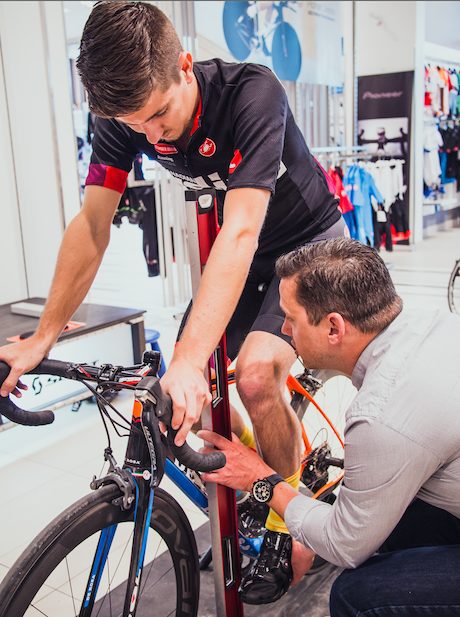Speed on a budget: Getting aero on the cheap
The easiest and cheapest tricks to improve your aerodynamics on race day.

— By Kerry Hale
It was quite some time ago that the term “aerodynamics” became the hottest word in cycling. And rightly so, because whenever we pedal our bikes, there is an invisible force that we are fighting in our bid for speed. To go faster requires that we reduce the effects of air resistance. At race pace, roughly 75 per cent of a rider’s power is used to overcome aerodynamic drag and, at even higher speeds, this air resistance consumes almost your entire power output.
If you believe that only serious bike racers can benefit from improving aerodynamic efficiency, think again. All cyclists and triathletes can benefit from a few tips and aero tweaks. Adam Kourakis of Velofix, North America’s largest fleet of mobile bike shops, is in the business of helping athletes become comfortable, safe and efficient on their bike. As owner and operator of four Velofix franchises across Canada, he’s also a tri coach and a successful age-group triathlete.
According to Kourakis, “It’s true that having the right equipment is part of the aerodynamic equation. You have to know how to maximize the equipment you’re using, but it’s not all about equipment. An aerodynamic position on the bike is crucial to performance; it will minimize frontal surface, which is the amount of space the hits the air when riding forward. Less surface area creates less drag and allows an athlete to ride with less resistance, equating to higher speeds and a more efficient ride.”
Getting more aero can be an expensive business. Often athletes pay big bucks for state-of-the-art, tricked-out rigs that run well into the thousands of dollars. Then there’s the deep-dish carbon wheels that are sure to burn a hole in the bank account, wind tunnel testing … the list can go on. These measures are simply beyond the reach of many triathletes.
The good news is that there are cheap – and often free – ways to get more aero. Here are 10 tips, as discussed by Kourakis, that are well worth considering:
Bike fitting
Typically costing between $150 and $300, a bike fit is worth its weight in gold. “A good bike fitter will optimize your position for comfort and performance and give you tips on body position and pedal stroke. In most cases, you’ll get some body position charts and measurements to take away, so that you can set up a second bike with similar geometry.”
Properly placed hydration
All the time spent getting a bike fit and optimizing your position lose their benefit if you have to constantly shuffle around to get hydration and nutrition in. “Reaching around to get bottles, gels, salt, etc. are all examples of breaking aero and will slow you down. Smart athletes will tape gels to their top tubes, sneak salt tablets into their aero bars and get a hydration system that fits well into the frame and allows for easy access.”
Aero helmet
Typically running between $150 and $300, an aero helmet is a little spendy, but combined with a proper bike fitting will minimize frontal surface and therefore the turbulence of the air coming off your helmet and body. “It’s not exactly free speed, but all the wind tunnel tests suggest that helmet shape really does matter.”
Drafting
Most triathlons aren’t draft-legal, but there’s still a small advantage in being just outside of the draft-zone. “Check your race rules before you start and try positioning yourself behind another cyclist as close as the rules allow.”
Clip-on aero bars
While this may be redundant for those triathletes already riding a tri bike, clipon bars will help create a position that’s more aero without having to buy a time trial/triathlon frame. “This option is also a great way to get more aero on a hilly bike course where the geometry and handling skills of a road bike might be more suitable.”
Shoe covers
Shoe covers aren’t always easy to put on during transition, but if you’re doing a TT, or even a long-course road race or triathlon, they are seriously worth thinking about. “The aero advantage will often outweigh the added transition time.”
Wheel cover
In most races – depending on the course terrain – a rear disc wheel has an aero advantage. If you’re looking to shave some time without having to buy a new rear wheel, consider buying a wheel cover. “It sits over the spokes and fills in the rear wheel much like a disc wheel. It has the effect of slicing through the air with far greater efficiency.”
Shave your legs
This last tip is likely the most contentious. Many suggest that smooth legs are to prevent road rash in the event of a fall, or for aesthetics, or perhaps purely because “that’s what cyclists do.” According to Kourakis, “Shaving your legs from the knee down saves you an average of 4 watts.” In essence, then, it’s a micro-dose of free speed. “But,” adds Kourakis, “for the guys amongst us, there’s no evidence to suggest that a beard causes any extra drag.”
Getting aero doesn’t have to be the exclusive domain of those who can afford it. By following the above tips, you will be on your way to a faster and more efficient bike split without having to drain your bank account in the process.
Kerry Hale is a triathlete and freelance journalist from B.C.’s Comox Valley.

